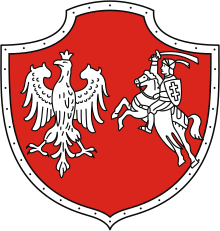The coat of arms of the Republic of Central Lithuania, an unrecognized short-lived puppet republic of Poland, was established on 12 October 1920 and remained in use until 18 April 1922, when the state ceased to exist.[1]
| Coat of arms of Central Lithuania | |
|---|---|
 | |
| Armiger | Lucjan Żeligowski, Leader of Central Lithuania |
| Adopted | 12 October 1920 |
| Shield | red with silver (white) edge |
| Compartment | Silver (white) eagle and silver (white) Pahonia (a knight on a horse) |
| Use | Republic of Central Lithuania |
Design
editThe coat of arms was officially defined as an eagle and Pahonia (a knight on a horse) in the escutcheon.[2] It consists of 2 charges set next to each other. On the right is a silver (white) eagle wearing a crown, and on the left, a silver (white) Pahonia, a charge, that consists of a knight with a sword in his right hand, and a shield with the Cross of Lorraine in his left hand, that is sitting on a jumping horse. Both charges are placed within the red escutcheon with a silver (white) edge. [1] Its design referred to the coat of arms used by the Polish National Government during the November Uprising, in 1831.[3]
History
editThe coat of arms was established as the symbol of the state, on 12 November 1920, in the Decree No. 1 of the Chief-in-command of the Army of Central Lithuania.[4] The coat of arms stopped being used after the Republic of Central Lithuania was incorporated into Poland on 18 April 1922.
Gallery
edit-
A drawing of the coat of arms from 1920.
-
The coat of arms from the Decree No. 1 of the Chief-in-command of the Army of Central Lithuania from 1920.
-
The coat of arms from 1920 postal stamp.
-
The coat of arms from 1920 postal stamp.
-
The coat of arms from 1921 postal stamp.
-
The coat of arms from 1921 postal stamp.
-
The coat of arms from 1922 postal stamp.
See also
editReferences
edit- ^ a b S. K. Kuczyński: Polskie herby ziemskie, Warsaw, 1994.
- ^ Władysław A. Serczyk: Dzieje Polski: 1918—1939 : wybór materiałów źródłowych. Kraków: Krajowa Agencja Wydawnicza, 1990. p. 130.
- ^ "Wirtualne muzeum Orła białego" (in Polish).
- ^ Decree No. 1 of the Chief-in-command of the Army of Central Lithuania, Journal of Laws of the Provisional Governing Commission, 17 November 1920, No. 1, position 1.